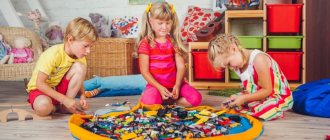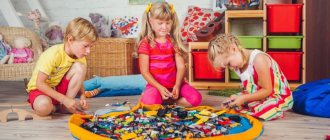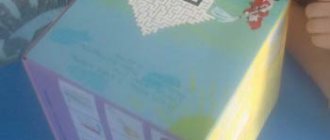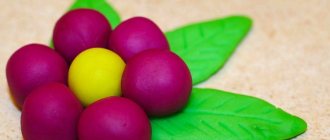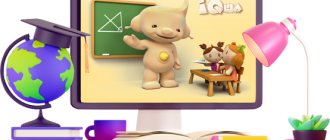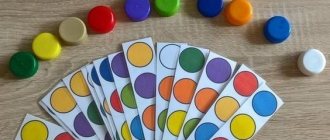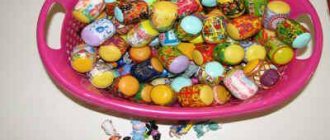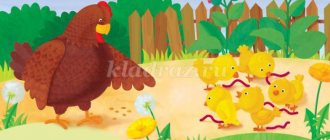1. Learn the concept of “many - little”.
2. Closer to three years - master the concept of “more-less” (determine the number of objects in a group - which ones are more and which ones are smaller).
3. Learn to distinguish between the number of objects “one” and “two”. (At a minimum. You can go further, learn to count to 3 - 4, but not all children aged 2 to 3 can do this - take into account the child’s interest and his abilities).
4.Learn to sort objects - by size, by color, by type (sort different types of pasta, buttons, large and small objects (circles, squares, etc.)), try other types of sorting.
5. Learn to navigate in space (learn the concepts of higher, lower, right, left).
6. Fold yourself, without the help of your mother, elementary puzzles or cut-out pictures from 2-3-4 parts (this skill develops gradually and becomes more developed closer to three years; at first, the mother helps the child).
7. Learn to match - play “who eats what”, “where is whose house”, “where is whose tail” (with cards or in pictures in books and manuals).
8. Play riddles - the mother describes an object or animal in the simplest form, the child guesses it from the description (for example - small, fluffy, with long white ears, jumps like that and eats carrots, who is it? Who says “moo-moo” and gives milk? Etc. Gradually you can complicate the riddles).
9. Guess the animal from the description.
10. Stack several nesting dolls and cups into each other.
11. Build a tower from cubes/cups with decreasing size values
12. Learn to compare figures, geometric bodies with their projections (Dyenesha blocks, homemade preparations)
13. Closer to three years - designing simple structures according to drawings
14. Starting from 2.5 years old - play “Fold the Square” by Nikitin (at first - together with the child, but very quickly children learn to assemble it on their own)
15. Starting from 2.5 years old – play with prefabricated puzzles
16. Learn to classify objects according to a general characteristic (for example: cards with pictures of toys, food, animals are laid out in front of the child. The child is asked to arrange them into appropriate groups (for example, toys in a box, food in a “refrigerator”, animals in a “house”). At first, the child learns to arrange objects with the active help of his mother.For the learning to be successful, it is better to play for a long time with the same set of objects (for example, to begin with, for a long time sorting cards of only toys and food).
Cards or wooden “Pick a Group” toys are great for mastering this skill:
17. Classification of objects - play the game “what’s in this room?” (find what is round in this room? What is soft in this room, etc.).
18. Games with Dienesh blocks, with a simple construction set, and other suitable items (toys, pasta, buttons, beads, etc.) by type:
– find objects, figures of the same shape;
– find objects, figures of the same color;
– find objects, figures of the same size;
– find the same figures by size, thickness and other characteristics.
19. Games with Cuisenaire sticks.
20. Play “part and whole” – “whose tail is this”, “match the roof to the house”, etc.
21. Learn to find a figure based on two signs (for example, find a large yellow circle (in a group of objects there is also a small yellow circle and circles of other colors), a small red square, etc.).
22. Closer to three years (and very individually) - find mistakes in pictures (working with manuals) - what is missing, what is wrong, which of the objects is the wrong color, etc. The very inexpensive manuals from the “Smart Books” series are great for this:
Studying the properties of objects.
1. Colors of objects.
2. Geometric figures, shapes. 3. Long-short. 4. High - low. 5. Wide-narrow. 6. Same and different (closer to three years). 7. Warm-cold. 8. Hard-soft. 9. Smooth-rough. 10. Heavy-light. 11. Taste, smell. Development of attention.
1. Play “Find it!” – we ask the child to find an object in the room (find where your teddy bear is, where the red cube is), on the street (look through the window - find where the dog is walking? Find the red car!), search in a picture in a book, etc. .P. – you can play anytime, anywhere. This game is very simple, children are easily drawn into it. At the same time, attention and the ability to concentrate it develop very well.
2. The game “Find a Pair” is a more complicated version than it was for a year or two - find a pair among objects that are very similar to each other.
3. Find the same pattern (pairs of mittens, hats, cups and saucers, patches for towels, roofs for houses, etc.)
5. Games with Dienesh blocks, Cuisenaire sticks.
6. Search for objects based on one characteristic - find what is red, hard, soft, round, large, etc. in this room. (you can play anywhere).
7. Search for objects based on two characteristics - find what is large and white, small and hard, etc. in this room.
8. Play hide and seek with the child (hide so that the baby can easily find it, prompt the child by calling him with your voice). How to develop memory.
1. “What’s missing?” - remember the pictures (toys) laid out on the table, guess which picture mom hid. Memorizing objects is carried out in a playful way - the mother tells a fairy tale about objects that are laid out on the table; during the process of the fairy tale, the child manages to remember its characters well. After this, mom takes one of them and asks “who is missing?” You can read more about how to play this game with very young children here.
2. What appeared? – we play according to the same principle as written in the previous paragraph, but we do not hide, but add toys, the child must determine which toy the mother added.
3. Hide 3-4 toys with the child. Then ask him to find them (we search from memory).
4. Ask the child to bring 2-3 items (we bring items from memory).
5. Together with the mother, remember what the child did yesterday, in the morning, some time ago, what events happened on the street (which friends were out today, what toys they had, etc.).
6. Remember what is drawn in the picture and answer questions about what was drawn there after the picture is closed.
7. Game “Find a Pair” with hide and seek – the mother shows the child a picture and hides it behind her back. Asks to find the same picture in a group of cards (the child looks for a paired picture without holding it in his hand, as usual, but from memory)
8. Game of “thimbles”. We take multi-colored cups and put a toy under one of them. We swap the cups several times, then ask them to find where the toy is hidden (we gradually increase the number of toys and cups).
9. “Memory” – a game with 2-3 cards. We put cards in front of the child, the child remembers them (to help him, you can tell a fairy tale about the heroes who are drawn in the pictures; while listening to the fairy tale, the child will remember the location of the cards well. The “fairy tale” can be very simple from 4-5 sentences). We turn the cards picture side down - this way, all the pictures are hidden from the baby and are not visible to him. We ask the child to find where a certain card is located from memory (“find which card has a bear on it?”). Another version of “Memory” can be found here. Physical development.
1. Jump in place on two legs. Closer to three years - learn to jump forward (but not everyone succeeds in this).
2. Learn to throw and catch a ball, throw a ball against a wall.
3. Throw up a balloon or ball.
4. Maintain balance while walking along a board placed on the floor, along a bench, or a beam.
5. Depict animal movements as shown by mother.
6. Crawl (like a boa constrictor, like a caterpillar) on your stomach forward.
7. Jump like a bunny.
8. Pretend to be a bird - wave your arms while running around the room, squat - “look for grains in the grass”, jump - “fly up”.
9. Stomp loudly, raising your legs high, like an elephant.
10. Swim like an octopus: lie on your back, raise your arms and legs up, wave your arms and legs (“swim”).
11. Run fast, slow, on your toes.
12. Sitting on the floor, knock on the floor with your feet, “like a drum.”
13. Roll on the floor like a bun.
14. Jump from a half-squat like a frog.
15. Dance and practice logorhythmics (to the music of the Zheleznovs and other authors).
16. Lift objects from the floor by bending or squatting.
17. Reach your arms up, reaching for objects that are located high (the mother can hold objects at the height of the child’s outstretched arm).
18. Move around the room without touching objects scattered on the floor (for example, pillows), gradually increasing the pace and number of objects.
19. Carry large, but not heavy things (for example, a highchair, a light box of toys).
20. Walking on massage surfaces.
21. Walking on tiptoes, closer to three years - on heels.
22. Perform dance movements - place the foot on the toe, on the heel.
23. Walking along a winding line drawn on the floor (or a strip of paper) - development of coordination.
24. Crawling under a tight rope.
25. Game “Catch a sunny bunny” - we play with a sunny bunny that mom lets out.
26. Collective games: dance in a circle, run like a train after each other (children hold on to each other), games with a special children’s play parachute, games of “catch up”, “wolf and bunnies”, etc.
27. "Cat and mouse." While the cat is sleeping (an imaginary cat or another adult), the children and mother walk quietly. When the cat wakes up, they quickly run into the house.
28. Hanging on the horizontal bar, rings, mother’s hands.
29. Climb on sports walls at home, on playgrounds.
30. Walking on “bumps” (chaotically scattered pillows, books).
31. Climb through a tunnel (purchased or built from chairs placed in a row).
32. Fitball games.
33. Game “Snail and House”. The child gets on all fours. A pillow is placed on his back. He turns into a snail, which carries its house (pad) on its back. The snail's task is to walk as long as possible without dropping its house (we crawl on all fours, carrying a pillow on our back).
34. Walking on your hands
Music and rhythm.
1. Listen to a lot of songs according to age.
2. Learn to listen to music - listening to classical melodies with your mother, listening to your mother’s story “What does this melody tell us?” It’s easy to come up with such a story yourself (for example, like this), with its help the child develops the ability to truly listen to music, to capture its shades and mood.
3. Learn to distinguish between fast and slow music, learn to play noise musical instruments quickly and slowly.
4. Learn to distinguish between happy and sad music.
5. Learn to distinguish between loud and quiet music, learn to play noise musical instruments loudly and quietly.
6. If there is an opportunity (large family) to play the game “who called?” (the child guesses by voice who is calling him).
7. Listen with your mother to the “sounds of life” - birds chirping, a car making noise, leaves rustling, etc.
8. Try to determine where the sound is coming from (for example, “do you hear a bird chirping? What tree do you think it’s sitting on?”).
9. Practice logorhythmics (to the music of the Zheleznovs and other authors).
10. Play musical instruments (children's and noise instruments - drum, maracas, tambourine, xylophone, etc.).
11. Get acquainted with various instruments and their sounds (you can watch videos on YouTube with your child, where performers play classical music on various instruments).
12. Closer to three years (if the child is fond of songs and remembers many melodies by ear) - play guess the melody - the mother sings the melody (“A Christmas tree was born in the forest”, “Antoshka”), the baby guesses what kind of song it is.
13. Sing songs to your child.
14. Dancing - fast, slow, stamping your feet, clapping your hands, twirling your palms - the "flashlight" movement, jumping, putting your feet on your toes - on your heels when dancing, tapping your heel on the floor, tapping your toes on the floor, doing a round dance, dancing with objects – spoons (we dance and knock spoons on the floor, against each other, over our heads, behind our backs, loudly-quietly, quickly slowly), maracas rattles (we dance and accompany ourselves, perform the same movements as with spoons), with handkerchiefs ( alone and in pairs with mom.)
15. Encourage independent performance of dance movements to dance tunes. Intensify the performance of movements accompanied by music that convey the character of the animals depicted. Drawing.
1. Draw paths.
2. Draw circles
3. Draw simple compositions - rain, snow, grass, Christmas tree decorations on the tree, circles (which will be balls, apples, etc.), draw sticks - strings for balls, stems (sticks) for flowers, handles for shoulder blades, hedgehog needles, grass, patterns (random) on cups, rugs, towels.
4. Draw vertical and horizontal lines.
5. Draw short and long lines.
6. Closer to three years - color pictures (some drawing teachers are against coloring - they believe that coloring kills creativity (since the child does not draw on his own, but works according to a ready-made template). Decide individually whether to teach your child to color or not).
7. Draw the child’s attention to the choice of color for the drawing (we draw the grass in green, the rays of the sun in yellow).
8. Draw with a stick on sand, semolina, snow.
9. Leave prints with paints using stamps and sponges.
10. Learn to paint with paints (wash and wet the brush).
11. Paint with finger paints. Modeling.
1. Roll out plasticine and dough with straight and circular movements of your hands (balls and sausages).
2. Break off small lumps from a large lump, flatten them with your palms and fingers.
3. Connect the ends of the rolled stick, pressing them tightly against each other.
4. Just play with dough and plasticine (free creativity).
5. Sculpt lumps of plasticine onto paper (feed the chicken, make dots for the ladybug, etc.).
6. Master the technique of smearing plasticine on paper.
7. Leave imprints on the dough with various objects.
8. Cut out shapes from the dough using cookie cutters.
9. Learn to cut dough with a plastic knife. Application.
1. Make a plot applique (sun + cloud + house, etc.) from 2-3 objects.
2. Apply an object of 2-3 parts (houses (roof + window), mushrooms (hat + leg), etc.).
3. Applique made of cotton wool (depict clouds, snow, dandelions, sheep, etc.).
4.Applique made from crumpled up lumps of paper.
5. Applique made from torn paper. Construction.
Build houses, fences, bridges, a slide, a garage. Play with Lego. Closer to three years - build houses according to a simple drawing (from two or three parts). Games with Dienesh blocks. Games with Cuisenaire sticks.
The world.
1. Continue studying domestic and wild animals and their young. Learn simple facts about animals (where they live, what they eat, characteristic features, for example, “a cow gives milk”, “a goat butts”, etc.), learn what domestic animals give to a person, learn the names of the main parts of an animal’s body (horns) , hooves, etc.).
2. Birds - expand your knowledge about bird species, study basic facts about birds (where they live, what they eat, how offspring appear, names of chicks). Get acquainted with the division into domestic and wild birds (simply talk about this with the child, when studying birds, emphasize that someone lives next to a person and benefits him, someone is a wild bird and lives on its own).
3. Insects – study the most common insects (ant, bee, butterfly, etc.); know the simplest facts from their life (a bee brings honey, a caterpillar gnaws on leaves, etc.), recognize them by their appearance, and cultivate a kind attitude towards insects.
Developmental activities for children 3 - 4 years old “The world around us”
Author I. Bushmeleva. Artist N. Gubareva.
At the age of 3-4 years, a child should be able to determine the time of day without difficulty.
Task for a child : Look carefully at the picture and say what the artist mixed up, what he drew incorrectly, why?
A child aged 3-4 years usually already knows that different vehicles are driven by different people. Tell him the name of the professions “machinist”, “tanker”, so that these words will enrich your child’s vocabulary.
Task for the child: Pick a pair. What kind of transport does this or that driver drive?
The child must answer your questions. It is important to present everything in the form of a game.
Assignment (questions) for the child:
1. In the morning the sun rises, and in the evening... (sets)
2. It rained, and... (puddles) appeared on the asphalt
3. Birch has leaves, and pine has... (needles)
4. In winter it often snows white, fluffy... (snow)
5. Water flows from the tap. And when it freezes, it turns into... (ice)
6. Is the ice soft or hard? (solid). Can it flow like water? (No). Is it cold or warm? (cold). Is the water cold or warm? (can be cold and warm).
A 3.5-4 year old child must distinguish animals that can live in city apartments from animals living in the countryside.
Activity with a child: look carefully which of these animals live in the village.
We teach a child to recognize a tree by its leaves. We study the names of flowers.
Task for a child : look at the leaves, from which tree did they fall (birch, maple, willow)? What are these flowers called (chamomile, rose, tulip, cornflower)?
A child of 3-4 years old, of course, already knows wild animals (from fairy tales, pictures, poems). He must be able to describe the animal and tell some of its features.
Activity with a child : There are animals in the picture, name them. Which one of them lives, where does it live, what does it like to eat, what color is its skin, which one is bigger? What are the “legs” of a wolf (paws) called? What about the elephant's nose (trunk)? Which animal has the largest neck, ears, teeth?
A child of 3-4 years old should be able to separate vegetables from fruits and voice the fact that some fruits are vegetables (grow in the garden), and others are fruits (grow on trees).
Assignment for a child: Miraculously, the tree grew fruit. Name them. Look and tell me which fruits do not grow on trees. Where do they grow?
A child aged 3-4 years already knows that there are adults and children. But what are they called correctly?
Activity with a child : Please tell me who is drawn in this picture (animals, beasts)? Please note that these are parents and their children. Do you know what they are called? (elephant (elephant) - baby elephant, bear (shema bear) - bear cub, cat (cat) - kitten, tiger (tigress) - tiger cub).
A 3.5-4 year old child should already know polite words and be able to use them correctly.
Lesson with a child: question - answer. Ask your child to answer your questions.
- In the morning you woke up and went to brush your teeth, on the way you met your mother. What will you tell her? (Good morning).
- In kindergarten, the girl Tanya treated you to an apple, and you told her... (thank you).
- You have friends? What are their names? If your friend asks you to help him, what will you do? (I'll help).
- Do you go to kindergarten? What time of day do you come to kindergarten (in the morning), and when do your parents pick you up (in the evening).
- What do you say to your family when you go to bed (good night).
- You came to visit a friend, what will you say when you see him? (Hi Hello).
- Mom asked you to help her clean the room, what will you do? (I’ll help, collect toys, etc.).
- Grandma was knitting socks for you, and her ball of yarn fell, what will you do? (I'll pick it up).
Sensory
It makes me happy when I hit a point of interest and the child gets carried away for a long time and tries something. So recently I noticed her craving for construction, and we purchased a magnetic construction set. I spent the whole day building it and couldn’t tear it away.
Developmental activities with sensory materials are very useful from the age of 3 years. They influence fine motor skills and indirectly prepare for writing and mathematics, as well as geometry and creativity. I made several sets with my own hands.
Noise cylinders. I made sound bottles from packages from Imunele - I simply poured beans, buckwheat and semolina into them. It is better to take cereals of different sizes.
Mysterious bag. You need to put objects of different shapes or textures into an opaque bag. The older the child, the less different they should feel to the touch. To complicate the game, you can add a second bag with the same contents. Ask them to find the same objects with different hands.
Paired color cards. A game-exercise on knowledge of colors and all shades. It starts with three basic colors and gradually increases in complexity to seven shades of each color: from the brightest to the palest. I want to get cards from the paint store so I can line up the colors.
We also arrange the chocolate egg fixies according to height. Or while walking in the forest we look for thick and thin trunks.
We have 2 rooms in our apartment: a kitchen-living room and a bedroom. In the living room there is a separate children's bookcase and a shelf for books. I change the materials from time to time, so this is once a creativity zone, once a music and sensory zone, but a set for caring for plants and a jug of water are always in their place. Nearby there is a workplace consisting of a table with a chair and a shelf for books.
One day one letter.
You can quite successfully teach your child letters on the street. There are a lot of games for learning letters outdoors. For example:
— Mom draws a letter on the asphalt with chalk and memorizes it with the child. Then asks him to name words that begin with this letter (on his own or with his mother’s prompts). When the child names a word, the mother draws a picture depicting this word (children love it when adults draw something for them, so drawing is a great way to attract the child’s attention to learning letters).
— Mom draws a lot of letters on the asphalt with chalk, among which will be the letter that the child learned today. The mother asks the baby to find the desired letter among all the letters and circle it (or cross it out). (“Look how many different letters! Find where the letter “K” is hidden!).
— Mom draws letters in chalk at a short distance from each other. Then he asks the child to jump over the letters as if over bumps. When jumping on each letter, the child must remember the word that begins with this letter (the mother can give hints at the same time) or simply remember the name of the letter together with the mother.
— the mother begins to draw a letter with chalk, stops somewhere in the middle, then hands the chalk to the child and asks him to finish drawing the letter.
- the mother draws a letter on the asphalt (so that it can be painted) and asks the child to color this letter with chalk.
- the oldest way of learning letters from our mothers and grandmothers - we study the letters on signs and plates that you see on the street.
Developing attention while walking.
"Find"
Find where the red car is here? Can you find a birch tree? Where's the yellow bench? And so on. These simple tasks develop the child's attention well. You can start with simple tasks, and gradually complicate the description of the objects you need to find:
“Find the little green leaf”, “find the black bird”, “find the little dog”, etc.
"Guess and find."
Describe to your child an object that is on the playground, but do not name it. Let the child guess what you wished for and find this item. For example:
“Find what I wished for - it’s on this playground, it’s made of wooden boards, people like to sit on it” (bench).
"Stories for attention."
Come up with a simple story for your child to listen to.
The plot could be like this:
A hedgehog went out for a walk. There he met a squirrel and a bunny. They started playing together. Suddenly a wind blew, it swirled everything around, there was a lot of dust, and when the wind died down, it turned out that only a hedgehog and a squirrel remained in the clearing. Guess who was carried away by the wind?
This is just an approximate “story plan”; the real story, of course, will be richer in detail and more interesting. So that the child can clearly remember all the characters in the fairy tale and quickly be able to answer the question “who is missing?” - you need to try to come up with a story so that the names of all the characters (hedgehog, bunny, squirrel) are heard at least 4-5 times (the more, the better). Thanks to this, the child will have time to get used to each of the characters, easily remember them and be able to easily answer the question “Who is missing?”
To begin with, you can come up with a very simple version of a story to develop attention - it will feature only two heroes. Gradually, the number of heroes who need to be remembered can be increased.
Activities and games during summer walks for children 3 years old.
- Seal
Details Author: Nalivaykina Lyudmila Published May 27, 2016
Summer is coming - a time of long walks, gentle sunshine and fresh air. In the summer, staying at home is a real crime - you want to walk as much as possible and enjoy the summer days.
Summer is not a reason to stop working with children. You can also play educational games during a walk in the summer.
Here you will find a selection of educational games and summer activities that can be done outside. Let your motto be “one walk - one educational game” - this pace will not tire either mother or child, and this summer you will not only relax, but also teach your fidget something useful.
Garden.
Your child will be incredibly happy and interested if you together organize his own small garden outside this summer. Even if you live in a high-rise building, you will definitely find a secluded place on the lawn near your house. Together with your baby, fence it off with pebbles or a small fence, clear it of vegetation, loosen the soil and water it.
And then do whatever you want: plant flowers, carrots, strawberries together... Or maybe you should plant a real beauty - grow a huge sunflower from a small seed?
Teach your child to look after your pets - weed weeds, water (in the morning or evening, explain what will happen if you water the garden in the middle of the day under the hot rays of the sun). Together, rejoice at the first shoots, admire the results of your work, and decorate the flowerbed with funny figures.
What does this give to the child?
Working in the garden for a child is his first biology lessons, a visual acquaintance with the life of plants. In addition, such manual labor develops motor skills, teaches responsibility, and simply makes you happy.
Fun math for a walk.
While walking on the street, you can play math games with your child:
— Mom draws small circles on the asphalt (flowers, boats, etc.). Then he asks the child to count how many circles are drawn. When the counting is done, mom draws the required number next to the circles (for example, three circles - draw the number 3).
— Mom draws a number on the asphalt and asks the child to put as many pebbles (flowers, twigs) next to it as the number represents (for example, next to the number 2 we put 2 flowers).
- Another simple and accessible way to teach counting while walking is to count various objects - steps, cars, pebbles, benches, trees, etc.
— While walking in the yard, play shopping with your child . You can sell and buy anything. And pebbles or leaves can serve as money. A spatula costs three rubles, which means we give mom three pebbles for it. And the bucket costs five - try to count out the required number of “coins”.
— We study “more and less.” We place three blades of grass and two pebbles in front of the child. Let the child answer which is more - pebbles or blades of grass.
— For this game you will need small animal figurines (for example, from a Kinder Surprise). A bunny, a bear and a squirrel found three “berries” in the garden (we place three pebbles in front of the child). Are there enough berries to feed all your friends? What if there are two “berries”?
Game No. 2 Where is this letter hidden?!
- Draw or find the beautiful letters you have learned. Print each letter in duplicate
- Select a game letter. Let's assume this is the letter "F"
- Keep one letter for yourself
- Hide the second copy of the letter and invite the child to find it
- Hide the remaining letters in accessible places as well.
- Show your child a letter, name it and ask him to find it
- Tell me if your child is confused and needs help.
- Remember! The child should be happy while playing and should not be upset that he cannot find the letter. If he starts to worry, then this method will become uninteresting for him.
Interests of three-year-old children
The main feature of a three-year-old baby is his increasing independence, but this should not frighten parents. If earlier he needed the help of adults, at three years old the child tries to do everything on his own, and you should not interfere with him in this. If you start to take care of your son or daughter, most likely they will grow up to be weak and insecure people. Therefore, to the best of our ability, it is necessary to encourage such a desire for self-expression, and not to crush it with the authority of a senior.
In addition, you can look at this with different eyes - by occasionally checking what the precious child is doing, dad and mom can allow themselves to rest or go about their business. The main thing is to guide the child in the right direction, to captivate him with something interesting.
The life of a three-year-old child still follows a certain schedule, and this should be so that he feels comfortable. Based on the fact that walking takes about four hours, the child spends most of the day at home, where his main activity is games, through which he continues his cognitive activity.
Despite the fact that the three-year-old already confidently walks and even runs, he spends most of his time on the floor, where he can play role-playing games, cars, or do creative work. This is quite normal, and it is not at all necessary to force him to sit at the table or on the sofa in order for him to do his business there. It is important that he feels free, both physically and mentally.
Personal care
Hygiene. For easy access to the sink, we placed a stool and hung a faucet extension. A towel, toilet paper, a basin for dirty clothes - everything is at the child’s level. He uses an adult soap dispenser: he presses with one hand, and places the other palm towards the hole from which soap drips.
During training, I reorganized the storage:
- she laid out combs, elastic bands, beads, bracelets and hairpins in different baskets;
- added teeth cleaning supplies;
- My husband and I hung a lower mirror.
Now if there is silence at home, we understand that the child is in the bathroom.
Dressing yourself. I myself really love order and teach my child to do it. My daughter puts her things back in their place, sometimes we have to remind them or do it together. It is clear that her independence and self-confidence are directly related to the fact that the necessary things are always available.
In the hallway I hung hooks for outerwear and a backpack. Opposite on the shelves in the closet I placed a basket with hats and mittens. Underneath it are stored outdoor toys and a bucket with a sponge and cloth for washing shoes. At the entrance there is a shelf with shoes for the weather, the rest is stored in the nightstand, just like ours.
I organized the wardrobe and hallway areas during the course for children under 3 years old, now I’ve just made small changes to make it even more convenient for my daughter. For example, I added the Trugen stool from Ikea. Dressing on it is clearly better than just on the floor or on an adult sofa, where your feet don’t reach the floor. True, now my daughter also uses it as a ladder to climb onto the sofa.
Children's clothes are stored on hangers and in the chest of drawers. I tried to place things so that they were as visible as possible. The chest of drawers is divided into sections to make it easy to maintain order.
